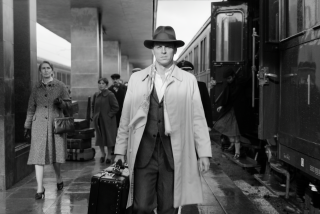A Second Wind : * The Sequel: Scarlett and Rhett of ‘Gone With the Wind’ are back, along with Ashley. The action moves to Ireland, and the hype moves to center stage.
- Share via
It’s getting hectic for Herb Bridges, down in Sharpsburg, Ga. Reporters keep calling from Denver and New York and Paris, plus there’s an exhibit to be set up at the local historical society and another at Macy’s in Atlanta.
Such are life’s burdens when you own more “Gone With the Wind” collectibles than anyone else in the world and times like these arise.
“We went through this when the book was 50 years old in ‘86,” says Bridges. “Then we went through it again in ’89 when the movie was 50 years old. Now we’re doing it again in ’91 when the sequel’s coming out.”
“The sequel.” That’s what Alexandra Ripley wanted to call her new book. But Warner Books, the publishers, preferred “Scarlett: The Sequel to Margaret Mitchell’s Gone With the Wind.”
It reaches book stores today--a million and a quarter copies, in 18 languages, in 40 countries. Before film sales, TV or china from the Franklin Mint, Margaret Mitchell’s heirs will earn about $10 million from the book Mitchell insisted never be written.
Oh--yes, Scarlett and Rhett do get back together. But not at Tara. And with a 4-year-old daughter. And not before Ripley bounces Scarlett back and forth between Charleston, Atlanta, and Savannah for 433 pages, then leaves her in Ireland for 390 more.
More than five years ago, the trustees of the Mitchell estate hired Ripley to continue the saga and to protect copyrights to the characters that otherwise would expire in 2011. The author of popular epics about Charleston and New Orleans, Ripley doesn’t believe the estate ever considered anyone else.
“I’ve always kept my eye on the competition,” says Ripley, 57, leaning back on the sofa in the elegant Manhattan hotel room where she is ensconced for the first hectic rounds of publicity interviews. “And I am the only real Southerner writing Southern historical novels. I’m the only one doing the ‘Gone With the Wind’ kind of thing.” Among her books are “Charleston,” “On Leaving Charleston” and “New Orleans Legacy.”
But Ripley moved her tale out of the South and the United States. “I started finding out what was going on in American history, and it was”--she squinches her mouth up and sings a word-- “nuh -thing.”
Luckily, Scarlett was an O’Hara. “I started reading up on Ireland,” says Ripley, “and I thought, ‘Thank you, God.’ What we have at this time in Ireland is like 20 years before in the (United States). Civil War actually broke out.”
The publishing community has known of Scarlett’s search for roots for quite some time. Otherwise, the book has been mostly a mystery. Warner publicists have engineered a splashy publication, including items on this evening’s networks news shows and “Entertainment Tonight,” and, Thursday, with Regis and Kathie Lee.
Reporters received copies last weekend, under oath that their articles wouldn’t appear before today. No prepublication copies surfaced, even in New York’s book world. That led to rumors that “Scarlett” was a bust, especially as “Gone With the Wind” made its name being passed hand to hand long before it reached book stores.
Orchestrated hype is only one difference between the sequel and the original. Scarlett O’Hara has changed, too. Ripley’s heroine is a single mom whose hurts feel better when she sees her baby. Her obsession is not survival but love for Rhett. When her old crush Ashley Wilkes finally proposes, on Page 620, this Scarlett says no.
“Now they could truly be friends,” she reflects.
This Scarlett wants to be happy, not to run lumber mills or stores. She wants others to be happy, as well--”their own way.” Margaret Mitchell’s heroine hobbled home to Tara swearing she’d never be hungry again. Ripley’s smuggles guns to Galway, then shops till she drops.
Darden Asbury Pyron, author of the forthcoming “Southern Daughter: The Life of Margaret Mitchell,” says Ripley’s Scarlett for the ‘90s may be right on target.
“One of the things that made ‘Gone With the Wind’ work,” he explains, “is that Margaret Mitchell was not only trying to be true to the historical reality of 1860 to 1872 but also trying to speak in the voice of the 1920s.” Any sequel writer, says Pyron, would have to strike a new balance between Scarlett’s day and her own.
More writers will have that chance, says Alexandra Ripley. She expects the estate to order up more Scarlett and Rhett books--”and, no, I’m not going to write them.” Why should she? Her deal brings her 15% of her book’s profits--more than a million dollars to start--plus a smaller percentage from future books using the characters she invented.
“Considering that they own Rhett and Scarlett,” she says, toying with a string of pearls, “I don’t see anything wrong with that. I have 15% of the works--of all the dolls and all the plates.” (Actually, no deals for dolls, plates--or movies--have been signed yet.)
Amid the hoopla, it should be noted that “Scarlett” is the second “Gone With the Wind” sequel to be written. In a late ‘70s deal between the Mitchell heirs, producers David Brown and Richard Zanuck and MGM, which owned rights to the original movie, “Tara: The Continuation of Gone With the Wind” was commissioned. Anne Edwards, the novel’s author, had written a biography of the celluloid Scarlett, Vivien Leigh. She later wrote another, of Margaret Mitchell.
The Zanuck-Brown deal dissolved in litigation, and “Tara” remains in a drawer. Edwards says her version never left the South, playing on Georgia’s new state government, yellow fever, the struggles of emancipated blacks and bad feelings toward Yankees. Her Scarlett and Rhett also reunited.
Ripley has heard about “Tara,” and plans to find a copy now that “Scarlett” is out. She says, “I’m curious.”
Herb Bridges isn’t. Between NBC and Paris-Match, he’s got plenty on his plate these days, and he couldn’t care less. To him, the sequel is just “a phase in the history of ‘Gone With the Wind.’ ” To purists, Bridges offers a word of advice Margaret Mitchell herself might appreciate: “If you don’t like the sequel, then forget it. Just go back to the original and pretend it never existed.”
More to Read
Sign up for our Book Club newsletter
Get the latest news, events and more from the Los Angeles Times Book Club, and help us get L.A. reading and talking.
You may occasionally receive promotional content from the Los Angeles Times.










